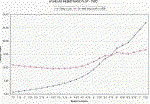We all come in different sizes, shapes and vary in degree
of fitness and strength. Most boats and kits are
manufactured and plans come for one or two standard sizes.
Kayak manufacturers have acceded to big and little people
with popular and good boats that have been stretched or
shrunk one or more dimensions to suit. We usually just
pick the one we feel most comfortable in, or the one whose
performance specs appeal to our self-image.
We also have particular uses that require specific lengths
or widths to get a particular carrying capacity, or a
storage space to fit, or a weight we can lift.
And we all like to dream a little too. We see ourselves
ahead of the pack, or multi-day voyaging in remote
locations. I read Mind over Water last year and Rowing
to Latitude, and On Celtic Tides this year.
Taking an armchair journey fires up our imagination.
In between building projects, I did some researching on
the web1 looking up "rowing physics" and
"kayaking physics", trying to get some additional design
data. I did pick up some great sliding seat rowing data to
add to an old chart of human output in horsepower,
versus time, for bicyclers, rowers and laborers from
my college biotechnology text. Then I added that data to a
chart by the Trireme Trust on their data for fixed seat
rowing, man-powered flight and bicyclers. And then I added
some data for Olympic kayakers from an old article. All
plotted on log-log paper to help flatten the curves into
nearly straight lines of decreasing net horsepower with
increasing length of effort.

Chart thumbnail
Olympic kayakers produce about the same effective
horsepower (arms only) as lightweight women Olympic rowers
(arms and legs). Scattered data for fixed seat rowers says
they produce far less, but a trireme rowed by college
students and navy fill-ins, a 31-foot cutter rowed by
strapping sailors nearly sixty years ago, or the Etonian 8
of 1870 is not quite in the same league of data. Even so,
the fixed seat rower data line is about 55% of the Olympic
kayaker line.
In fact, significant improvements in performance have
occurred in the last two decades due to advances in
training more than boats or rowers. In fact, "eights" are
going so fast now that the bottom on Olympic courses is
retarding their speed because the waves are constrained by
the depth.
The rowing physics data triggered an "Aha!" Since you can
predict horsepower output per pound2/3
(equivalent ratio to lung capacity) for heavy-weight men,
light-weight men, heavy-weight women, and light-weight
women Olympic rowers at the top of their training; and you
can then get it for untrained men and women as a percent
of Olympians performance (about 60%), then you can match
their projected output in horsepower to a boat's total
resistance in pounds times it's speed in feet per second
divided by 550. So you can theoretically get a boat that
"fits" a rower or paddler in both butt size and optimum
length and resistance to go their preferred training time
or all day, if desired.

Drag curve thumbnail
Since wave-making resistance of boats has maxima and
minima as the curve increases with speed as the various
wave systems generated by the hull overlap and then
partially cancel each other, you place a minima at their
desired horsepower for your time or distance. Voila!
Calculating drag and horsepower is not too difficult with
the right books, data tables and hand held calculator.
There are a couple of fairly accurate ways for small
craft, but the slickest at present is an Excel spread
sheet developed by Matt Brose of Mariner kayaks, and used
to compare kayak resistances in SeaKayaker magazine. It
works for other boats as well. It can be accessed on line2
and used, or downloaded and used on a pc or mac.

Drag Calc thumbnail
(At some point, I must recognize that many of us are math
challenged, or don't just dive into complex Excel spread
sheets like we know what we are doing. Find someone you
know who does! Engineers and scientists love a challenge.)
Finding your horsepower output is a little trickier.
Collegiate teams do lactic acid build-up testing on an
ergometer rowing machine. They row timed sets with
increasing resistances, heart rate monitoring and blood
testing to find where they top out in ability. Our muscles
burn oxygen and one waste product is lactic acid. When it
builds up, we feel that burning sensation in our arms or
legs that inhibits further performance. We can move the
level through proper exercises and distance training. They
check blood chemistry. We non-collegiate, non-rich can
measure our heart rates…a little less accurate.
One estimate for maximum heartbeat is 220 minus your age,
plus or minus 13. For me, that's about 160, between 147
and 173. Since I have a resting heartbeat (62) below
average of 72, I would expect to be closer to 150.
In short bursts, we create a short-term oxygen debt
(anaerobic), which we make up by breathing hard
afterwards. In long distances, rowing, cycling, hiking,
etc, we reach some oxygen equilibrium (aerobic) with our
heart, lungs and muscles. Some people have different
amounts of fast twitch, and slow-twitch muscle tissue
pre-disposing them for good distance running or rowing,
while others are good in the sprints. Similar to the very
few who can summit Mt. Everest without oxygen, a genetic
predisposition to success in certain sports.
We all have some maximal heart rate, at which point
increased effort does not raise our heartbeat, blood flows
no faster, and oxygen gets to our muscles at the same
rate…we top out aerobically. This too can be improved with
exercise.
As we age, our lung capacity and inhalation and exhalation
rates decrease. One estimate is that we lose 30% of our
lung capacity between age 30 and 70, or 8 to 10% per
decade for the average Joe. Another estimate used in
hospitals is 5 ml per year on the spirometer chart for all
people, independent of size or gender! Another is
virtually no decline for well-seasoned people who work out
regularly.
Determining heart rate is should be sport specific: You
can determine heart rate by running stairs, but it's a
good number for stairs. You can row on an ergometer. I
paddle or row a known distance (1/2 mile, 1 mile, 2 miles)
at a fixed rate and take my pulse and time to cover the
distance.
My "target heart rate" is between 120 and 130 for training
purposes at the lowest level of fitness according to some
rowing training books. That is found by taking between 60
and 70 percent of my maximum heart rate minus my resting
heart rate, and adding back my resting heart rate.
((150-60) * 0.7) + 60 = 123.
At age sixty, my theoretical maximum heart rate is about
150. A one-mile row at about 85% yields a pulse of 128.
Since I know the resistance of my boats, I can calculate
pounds of drag and feet per second, and thus horsepower
vs. heart rate for aerobic performance.
You can do this too. You just need a watch, a map giving
some fixed distances for rowing and a table of resistances
for your boat. If you are a kayaker, you can look it up on
line, or estimate it from very similar boats, or use the
calculator on line. If you are a rower, you might have to
work a little harder at getting resistance data for your
boat from the manufacturer etc. Or you can have Long Lake
Wooden Boats do the calculations for you. You can also
order stock plans and customize the lengths to some
extent.
Why bother? So you can finally get a boat that really fits
you, or one that you can train into for fitness or
distance rowing or paddling. Or one you can get onto your
roof-rack.
1www.atm.ox.ac.uk/rowing/physics,
www.atkinsopht.com/row,
http://filebox.vt.edu/eng/mech/tidwel/me4016/final/dynamic
2www.marinerkayaks.com/… |